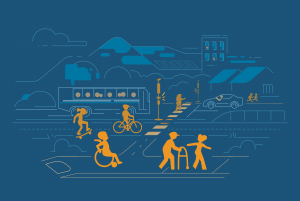
Week Without Driving
Leave the car at home and embrace transportation options

Imagine a week where we all choose transportation alternatives to driving our own cars solo: walking, biking, using public transit, or ride sharing. Sure, there may be some downsides – cars are oftentimes convenient – but think about the upsides. This shift in our behavior can significantly reduce traffic congestion, lower fossil fuel exhaust emissions, and improve our air quality. The Environmental Protection Agency (EPA) reports that transportation is the largest source of greenhouse gas emissions in the United States, so reducing vehicle use, even temporarily or occasionally, can have a powerful impact on our carbon footprint. This shift could also provide us health benefits, by walking and biking more. For those choosing public transit, travel time, instead of driving (and hopefully focusing on the road), can be time used for reading a book, catching up on work email – or taking a nap.
Week Without Driving (September 30 – October 6) was conceived to bring greater awareness to the issues faced by those who can’t drive in order to create more accessible communities for everyone, but the climate benefits reaped by driving less cannot be denied. Driving is often seen as an essential part of modern life, but it’s an option and privilege not everyone has. For many individuals, walking, biking, or relying on public transit isn’t just a choice — it’s their daily reality. Whether due to age-related limitations, medical conditions, anxiety, vision impairments or financial constraints, many non-drivers navigate the world without the convenience of a car. Participation in the Week Without Driving helps foster empathy for those who face these challenges every day and highlights the importance of accessible and reliable transportation options for everyone, as well as serving as an eye opener for how convenient and healthy some of the options can be.
By committing to a Week Without Driving, we not only contribute to a healthier planet but also gain a deeper understanding and appreciation for the value of transportation options. In cities like Los Angeles, you can plan car-free journeys with tools like the LA Metro app, which provides real-time information on buses and trains across the city. You can also explore the Metro Bike Share program for a different kind of adventure, accessing bikes from convenient locations throughout the city helping to move through and discover new parts of LA.
In smaller communities, like here in San Luis Obispo, resources like the SLO Transit app make it easy to hop on local buses, while the SLO County Bike Coalition can suggest great biking routes and safety tips. In both downtown San Luis Obispo and on the local Cal Poly campus, DCR has helped make a new program of bike lockers attractive and convenient for personal bike storage (learn more about this program here). For longer journeys in Southern California, travelers can take advantage of the Amtrak Pacific Surfliner, traveling up and down the coast without a car while taking in the beauty of the region all the way from San Luis Obispo to San Diego. These transportation services, and tools to access them, make a range of transportation options not just possible but inspiring.
During this week, your exploration doesn’t stop when you leave your front door. Dive into local transit systems, discover bike-friendly routes, and even take virtual tours of places that have implemented sustainable urban living. These steps help build a future where everyone can navigate and move around their community with ease, no matter their situation. Let’s embrace this opportunity to contribute to a cleaner environment, healthier communities, and more sustainable and equitable way of living.

Want to work with us? Feeling inspired?
Contact us at info@dcrdesign.net or checkout our social medias: LinkedIn and X
For more information visit:
Vision Zero Safe systems approach, NHTSA, FHWA and weekwithoutdriving.org




